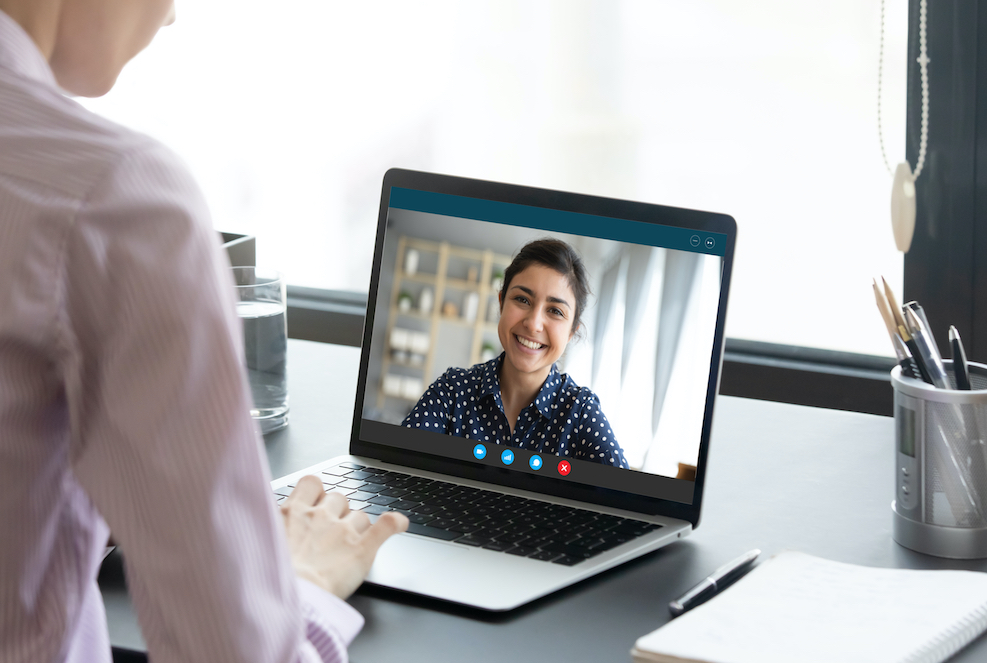[ad_1]
Frequently conceptualised as one of the most common anxiety disorders, Social Anxiety Disorder (SAD) is estimated – by an admittedly outdated study – to have a lifetime prevalence of around 12% of the population (Kessler et al., 2005). SAD is characterised by excessive fear concerning how one acts, and may be perceived, in social situations.
Clark and Wells’ (1995) influential model understands the disorder to be perpetuated by self-focused attention and negative self-image. Cognitive Therapy for SAD (CT-SAD), the standardised NHS frontline treatment, combines this model alongside the principles of Cognitive Behavioural Therapy, aiming to improve symptoms by challenging negative self-perceptions. The 14-week treatment emphasises behavioural experiments. One such experiment centres around video feedback, where patients are encouraged to challenge their negative beliefs whilst viewing a video of themselves in a social encounter.
As healthcare begins to shift towards digitisation, an internet-based, remote version of CT-SAD (iCT-SAD) has been developed. Requiring notably less therapist guidance and time, this allows professionals to take on more patients. However, this begs the question: in pursuit of efficient treatments, do we risk ignoring the value of in-person therapist interactions? And how do behavioural experiments like video feedback translate to remote formats?
Wild, Warnock-Parkes, Stott and colleagues (2023) set forth to answer this question by investigating previously unanalysed video feedback data from two recent studies investigating iCT-SAD.

During video feedback in iCT-SAD, patients receive digital prompts to encourage reflection.
Methods
Study 1 compared the effects of CT-SAD and iCT-SAD in a UK sample of 102 adults referred by NHS services for SAD treatment (Clark et al., 2022). Patients were assigned to either CT-SAD or iCT-SAD conditions and completed a 14-week course of treatment.
Study 2 replicated the treatment and measures of Clark and associates’ study, save the removal of the CT-SAD condition (Thew et al., 2022). Patients were 44 self-referred Hong Kong-based adults who met criteria for SAD and demonstrated sufficient understanding of English.
Video feedback occurred during the third week. Patients recorded, then viewed a video of themselves in a social interaction. In CT-SAD, reflection was guided by a therapist, whereas in iCT-SAD reflection was guided by digital prompts, with opportunity to text a therapist afterwards. Patients were required to complete questionnaires before and after intervention, rating self-perception statements (pertaining to anxiety, occurrence of feared beliefs and overall performance) on scales from 1-100, and a self-report SAD symptomology questionnaire (Leibowitz Social Anxiety Scale [LSAS]).
Results
Wild and colleagues opted to analyse video feedback data for each study independently, then in comparison. For sake of ease, I will present results in this order.
Study 1 aimed to determine whether iCT-SAD would be as effective as its face-to-face counterpart, CT-SAD. Interestingly, analysis of video feedback data showed the same overall trend in patients participating in each method of delivery. The trend was an overall improvement between pre- and post- intervention measures: significant decreases in self-perception of anxiety, occurrence of feared beliefs, LSAS anxiety ratings and improvement in ratings of overall performance. However, it is important to note that when compared using Linear Mixed Effect Models, CT-SAD was associated with a greater degree of change in self-ratings, but not LSAS, when compared to iCT-SAD. Albeit, it is crucial to put this into context – whilst CT-SAD may be more effective, the percentages of those experiencing improvement in both interventions are incredibly promising. Indeed, 100% of patients across conditions reported decreases in degree to which feared beliefs transpired, 98% of CT-SAD and 88% of iCT-SAD patients reported increases in self-rating of social performance, and 96% of CT-SAD and 92% of iCT-SAD patients reported decreases in self-ratings of perception of external anxiety.
Study 2 aimed to test whether the positive effects of video feedback within iCT-SAD would replicate in a Hong Kong-based sample. Indeed, the data supported the findings of Study 1, with significant overall improvement following intervention in all measures – self-perception as well as LSAS anxiety score. In fact, upon closer inspection of the data, it must be acknowledged that between 84-95% – a significant majority of participants – demonstrated improvement in each measure.
Finally, Linear Mixed Effect Models were used to compare the degree of change between the pre- and post-video feedback results between iCT-SAD groups in Study 1 and Study 2. Upon examining the extent of change, no significant difference between studies was found for any measure. In short, this means that the results of Study 2 exactly replicate the iCT-SAD data from Study 1. This further supports the evidence indicating the efficacy of the iCT-SAD video feedback in improving SAD symptoms following intervention and adds a cross-cultural element to the evidence base.

Video feedback was consistently associated with improvement in self-perceptions of social anxiety.
Conclusions
- Overall, results suggest that the video feedback intervention within iCT-SAD may be an effective means to challenge and decrease negative self-perceptions associated with SAD and further reduce social anxiety levels. This effect was supported in UK and Hong Kong studies.
- When investigating the effects of video intervention within iCT-SAD in the Hong Kong and UK-based studies, results were found to not significantly differ in regard to the degree of change of measures. Results are not only comparable, but replicated.
- However, upon comparison, video feedback within CT-SAD was associated with greater amounts of change in negative self-perceptions between pre- and post- intervention scores compared to iCT-SAD. This effect did not extend to LSAS scores.

This research suggests that video-feedback may be an effective technique used in treatment for social anxiety to decrease negative self-image and levels of anxiety.
Strengths and limitations
The researchers acknowledged a notably limited lack of control over timing of measures. Where self-report data was collected directly before and after feedback, LSAS anxiety scores were collected weekly. Additionally, patients in iCT-SAD were able to proceed with additional modules directly following feedback, so may be further along the course of treatment. Unfortunately, this means that effects must be interpreted with caution as changes may not necessarily be associated strictly with the intervention. The authors were unable to control for the amount of therapist guidance provided – in both CT-SAD and iCT-SAD conditions, which may influence the findings of this study.
This author draws attention to further limitations:
- Effects of video feedback were measured only in the short-term, within the week it was carried out. Hence, questions must be raised regarding longevity of positive effects associated with the video intervention.
- Conclusions are over-reliant on self-report data. Whilst it may be the most efficient way of understanding self-perceptions, self-reports inherently rely upon introspection and interpretation that may be unreliable.
- The participant pools of each study were relatively small and limited to English speakers. Further research is required to better understand the generalisability of findings.
- There is a lack of information in regard to patient retention, which may be significant in regard to cross-cultural effects, as UK patients were referred by the NHS whereas Hong Kong patients were self-referred and they paid an upfront cost for treatment.
However, the strengths of this novel research should be acknowledged. The study builds upon and adds to an existing base of knowledge, successfully furthering our understanding of specific elements within SAD treatment. Further, knowledge is applicable in a clinical setting since both versions of CT-SAD are currently in use, or being trialed within the NHS. A multifaceted approach allowed for a thorough investigation of effects, by analysing general effects, comparative effects, and cross-cultural evidence. Lastly, the use of self-report questionnaires allowed for measures of self-perception, a targeted outcome. Further, scores were quantitative which allowed for statistical analysis.

The use of self-reported data in this study can be considered both a strength and a weakness.
Implications
In order to contextualise Wild and associates’ findings, it is important to look at the both the specific and broader implications.
Firstly, specific. Upon looking at the overall effectiveness in improving immediate post-video outcomes, results seem to suggest that video feedback can be successfully carried out remotely. The replication of this effect in Hong Kong adds robustness to this conclusion. From a clinical standpoint, this is promising evidence that this specific adapted element of CT-SAD translates well to a digitised format. However here it must be noted that CT-SAD was found to result in a greater degree of change in negative self-evaluations, seemingly indicating video feedback carried out under direct therapist guidance to be more valuable.
At this point we must ‘zoom out’ to understand broader implications. In short, the study does support the use of digitised therapy for video feedback, even if it is not quite as effective. Remotely delivered therapies may indeed represent the future of treatment. We face a healthcare conundrum, with limited mental health professionals available to support growing numbers of those in need. Remotely delivered, digitised therapy allows for wider distribution of treatment as therapists are required to invest less contact time, and as such can take on more patients. Accordingly, patients may access treatment and recover faster. Indeed as we stand, we face problems in SAD treatment. Alongside high prevalence, low treatment-seeking and low rates of natural recovery are also observed (Waumans et al., 2022, Bruce et al., 2005). Is the shift to remote therapy one that will benefit both patient and therapist? Well… maybe, and maybe not. A digitised therapy may be more accessible – perhaps especially to those with social phobia – yet, in seeking efficiency, we may lose sight of the value of in-person therapeutic relationships.
However, this question is already being investigated. As of May 2023, NICE began assessment, with iCT-SAD currently being trialed in an Oxford NHS Talking Therapies service. This trial allows patients to opt-in to iCT-SAD and will measure outcomes over 7 months, including satisfaction with treatment (see Clark, 2023). We are now at the exciting forefront of discovering where remotely delivered CT-SAD fits within our healthcare system. The present research contributed an important understanding of video feedback, and whilst not as effective as face-to-face, the successful adaptation and positive implications should not be ignored.
Now, to leave you with some food for thought (or inspiration?). To build upon the foundation, this author believes we need further research into the longevity of video feedback effects, further cross-cultural studies, and finally an understanding of both patient and therapist opinions of accessibility and effectiveness in remotely delivered therapy for SAD.

Exactly how valuable is the face-to-face guidance that therapists provide during a video feedback session?
Statement of interests
The author has no conflicts of interest to declare.
King’s MSc in Mental Health Studies
This blog has been written by a student on the Mental Health Studies MSc at King’s College London. A full list of blogs by King’s MSc students from can be found here, and you can follow the Mental Health Studies MSc team on Twitter.
We regularly publish blogs written by individual students or groups of students studying at universities that subscribe to the National Elf Service. Contact us if you’d like to find out more about how this could work for your university.
Links
Primary paper
Wild, J., Warnock-Parkes, E., Stott, R., Kwok, A. P., Chan, M. H. L., Powell, C. L., … & Thew, G. R. (2023). Video feedback to update negative self-perceptions in social anxiety disorder: A comparison of internet-delivered vs face-to-face cognitive therapy formats. Journal of Affective Disorders, 331, 139-144.
Other references
Bruce, S. E., Yonkers, K. A., Otto, M. W., Eisen, J. L., Weisberg, R. B., Pagano, M., … & Keller, M. B. (2005). Influence of psychiatric comorbidity on recovery and recurrence in generalized anxiety disorder, social phobia, and panic disorder: a 12-year prospective study. American Journal of psychiatry, 162(6), 1179-1187.
Clark, D. M., Wild, J., Warnock-Parkes, E., Stott, R., Grey, N., Thew, G., & Ehlers, A. (2023). More than doubling the clinical benefit of each hour of therapist time: a randomised controlled trial of internet cognitive therapy for social anxiety disorder. Psychological Medicine, 53(11), 5022-5032.
Clark, D. M., & Wells, A. (1995). A cognitive model of social phobia.
Kessler, R. C., Berglund, P., Demler, O., Jin, R., Merikangas, K. R., & Walters, E. E. (2005). Lifetime prevalence and age-of-onset distributions of DSM-IV disorders in the National Comorbidity Survey Replication. Archives of general psychiatry, 62(6), 593-602.
Thew, G. R., Kwok, A. P., Chan, M. H. L., Powell, C. L., Wild, J., Leung, P. W., & Clark, D. M. (2022). Internet-delivered cognitive therapy for social anxiety disorder in Hong Kong: A randomized controlled trial. Internet Interventions, 28, 100539.
Warnock-Parkes, E., Wild, J., Thew, G. R., Kerr, A., Grey, N., Stott, R., … & Clark, D. M. (2020). Treating social anxiety disorder remotely with cognitive therapy. The Cognitive Behaviour Therapist, 13, e30.
Waumans, R. C., Muntingh, A. D., Draisma, S., Huijbregts, K. M., van Balkom, A. J., & Batelaan, N. M. (2022). Barriers and facilitators for treatment-seeking in adults with a depressive or anxiety disorder in a Western-European health care setting: a qualitative study. BMC psychiatry, 22(1), 165.
Photo credits
[ad_2]
Source link
